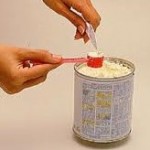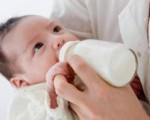Dispensing and Preparing Formula for baby
 Baby is fed with formula when breast milk is insufficient or to manage the frequency when mother is out for work or an errand.
Baby is fed with formula when breast milk is insufficient or to manage the frequency when mother is out for work or an errand.
Use boiled water for mixing formulas this will ensure your baby does not get infections and is healthy. Continue this practice as long as you are using a bottle for feeding. Need to be cautious on healthy hygienic practices.
Babies will not wait when they are hungry. They will cry loud such that the neighbours also will realize the presence of the baby.
Procedure to mix formula milk:
Wash your hands Always read the label instructions mentioned on the formula pack. Boil water in a clean vessel. Let it simmer for 3 to 5 minutes extra. Then leave the vessel for cooling until lukewarm. Now transfer the water into a feeding bottle which is clean and sterilized. Dispense the formula powder into the feeding bottle that has water. Tighten the nipple and cap of the bottle. Shake the bottle thoroughly.
Check for any lumps in the bottle, it will prevent flow of milk.
You can store boiled water in a flask sufficient for the next feed to avoid being away from the kid for long. You can plan for the night feed in this manner.
Water is the main source for bacterial contamination and as babies are very delicate they are infected quickly. It is a painful process for both mother and child therefore follow hygiene practices.
Check for the right temperature:
Check for the temperature of baby formula prior to feeding the baby. Sprinkle some milk from the bottle nipple onto the inner side of your wrist. It should not feel hot on your skin upon contact , you should feel similar to body temperature, not too hot that the baby will be affected.
How long can we store the formula milk:
It is recommended to use the mixed formula milk in an hour’s time. If the external weather is cold, it is advisable to warm the milk and then feed the baby. Do not serve left over milk beyond recommended duration, it may grow bacteria and your child may fall sick.
Heating the baby formula:
You can lightly heat mixed baby formula in the microwave too, use a separate clean vessel for that purpose. If the milk is too warm and the baby is shrieking with hunger, immerse the vessel partially into a bucket of regular water. This will bring down the temperature and you can feed the baby quickly.
Caution while dispensing baby formula:
- Use the scoop as supplied in the baby formula pack.

- Do not heap the scoop while dispensing baby formula Fill up to the scoop tip only.
- Do not compress the baby formula in the spoon . Normally dip and scoop out quantity.
- Follow right dilution of baby formula. Adding more water to the dispensed quantity is unhealthy as adding more baby formula to the water. This may cause indigestion, constipation and your baby may have colic problems.
- At all times follow manufacturer’s instructions mentioned on the pack. Read label, check for product expiry etc while purchasing baby formula.
How to Clean and Sterilize Bottle Feeding Equipment
 Your baby’s health is in your hands. You can keep your baby free from sickness and infections by cleaning and sterilizing feeding accessories. Your baby will not get affected by external germs that are present in the surroundings. A few techniques to be applied .
Your baby’s health is in your hands. You can keep your baby free from sickness and infections by cleaning and sterilizing feeding accessories. Your baby will not get affected by external germs that are present in the surroundings. A few techniques to be applied .
Cleaning of feeding equipment
- Wash the feeding bottle and accessories immediately after use. This will remove the foul smell that emanate when milk stales.
- Wash your hands too.
- Do not leave the nipple of the bottle in the open after feeding. Attracts flies and germs.
- Rinse the bottle , cap, nipple thoroughly in water and then use a bottle brush to remove any residue. Focus on the groves at the neck of the bottle as there is high chance of milk settling out there.
- Use mild liquid detergent to clean the bottle.
- Check the nipple for any damages. Wash nipple inside out and ensure water flows from the hole of the nipple.
- Complete rinsing of bottle , cap and accessories in hot water too.
Why to Sterilize the feeding equipment
Sterilization is a very critical activity. Sterilizing feeding bottles and accessories ensure all germs and bacterial are killed. Sterilization is effective if proper cleaning is done.
Babies are very delicate and have an immature immune system. Babies cannot fight germs as easily as grown up’s do. An illness that could cause a minor inconvenience for an adult could be very serious for a little baby.
It is advisable to sterilize bottles used for feeding i.e water or baby formula until baby is nine months old. Once baby is crawling and moving around you can wash the containers immediately after use and dry it in sunlight to avoid infection.
How to Sterilize the feeding equipment
 After cleaning feeding bottles, nipples and caps place them into a clean bowl. Fill water in it such that the accessories are immersed. Boil the water in the bowl.
After cleaning feeding bottles, nipples and caps place them into a clean bowl. Fill water in it such that the accessories are immersed. Boil the water in the bowl.
Ensure no contact of plastic to the sides of the bowl, shape will get distorted. Decrease the flame and continue further boiling for 5 more minutes. Leave the lid on the bowl during cooling also.
Wash your hands before removing bottles and other accessories from the water. Use tongs to pick the bottle from the bowl if hot.
Remove the bottle and place it on a clean tissue paper or SS rack. Once it is dry place the nipple inverted and close the cap . Effective for four to six hours when dry and there is no moisture.
Watch out in case of feeding bottle nipples:
Latex nipples are softer and more flexible, but they don’t last long . Silicone nipples are firmer and hold their shape longer. You can choose latex, silicone, or rubber nipples. Replace the nipple upon deformation of shape or expansion.
Your baby is in safe hands upon following all the instructions. You can enjoy motherhood as the days go by.









